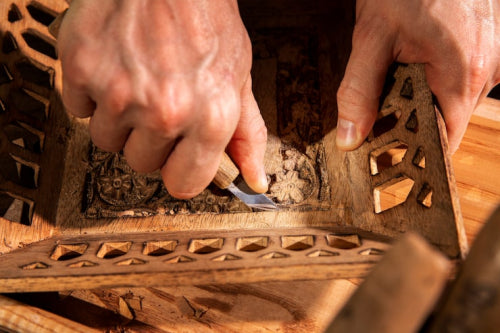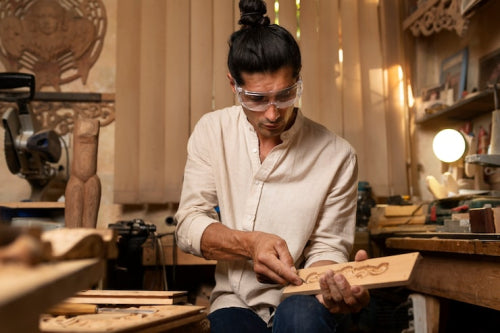In the relentless pulse of Mumbai's high-rises, where monsoons lash against glass facades and families navigate lives in ever-shrinking spaces, a simple cane chair becomes more than seating it's a statement of resilience. Foldable tables vanish into walls at dusk, sofas conceal workspaces for the endless hybrid hustle, and wooden frames withstand the city's unyielding rhythm. This is the new normal for urban India, from Bangalore's innovation hubs to Jaipur's craft-laden lanes. Furniture studios nationwide are not merely responding; they are redefining domesticity, fusing age-old craftsmanship with forward-thinking functionality. Dive into Transforming Spaces: How Furniture Studios in India Adapt to Contemporary Lifestyle Demands, where we explore this evolution, grounded in market realities and creative ingenuity.
Mass-market furniture lacks heart, filling rooms with bland, short-lived pieces. Frequent breakdowns spark frustration, as replacements erode style and sentiment. At MMC Wood Creations, Udaipur artisans shape heirloom furniture with enduring craftsmanship and cozy elegance, creating pieces that echo your identity, ensuring your home radiates warmth and timeless connection. Shop Now!
Emerging Trends and Developments in Furniture Design
The furniture sector pulses with transformation, driven by imperatives of space, technology, and environmental stewardship. Consider Chennai's coastal bustle: Designers there are pioneering smart integrations, like armchairs with built-in charging stations and ambient lighting that adjusts to the room's mood. These innovations cater to a workforce increasingly blurred between office and hearth, where evenings blur into Zoom calls under flickering tube lights. Globally, such advancements underscore a broader shift toward multifunctional designs that maximize utility without compromising elegance.
Compact urban dwellings demand ingenuity, particularly in Pune and Jaipur, where real estate premiums force residents into micro-apartments. Here, furniture evolves into versatile allies ottomans that unfold into guest beds, wall-mounted shelves that double as desks, all hewn from resilient, lightweight teak or bamboo. The global multifunctional furniture market stood at USD 15.9 billion in 2024, poised for a 4.9% compound annual growth rate through 2034, propelled by precisely these spatial constraints. In India's burgeoning metros, where high-rises multiply amid population pressures, such pieces transcend convenience; they embody essential adaptation, ensuring homes remain sanctuaries amid the squeeze.
Sustainability emerges as the ethical cornerstone, reshaping sourcing and production across the board. In Kolkata's aromatic workshops, artisans repurpose discarded cane from rural cooperatives, crafting heirloom-quality items that echo circular economies. Ahmedabad's innovators, meanwhile, champion bamboo composites that thrive in arid climates, reducing carbon footprints while delivering enduring strength. This ethos aligns with seismic market dynamics: Asia Pacific held a commanding 48.68% share of the global furniture market in 2024, valued at USD 276.77 billion, with projections for a robust 6.19% CAGR over the forecast period, largely attributable to rising eco-awareness in regions like India. Buyers today seek not transient trends but narratives of longevity furniture that matures gracefully, much like a well-seasoned narrative, rather than discarding like yesterday's news.
These currents extend to outdoor realms, vital in Hyderabad's languid evenings. Weather-resistant wooden pavilions and swaying cane hammocks defy seasonal onslaughts, inviting al fresco living in balcony-bound existences. Such designs bridge lofty ideals with grounded needs, offering durable luxury at accessible prices a hallmark that positions Indian studios as agile frontrunners in a competitive landscape. Wood materials, commanding a 43% global share in multifunctional segments last year, continue to lead with a projected 5.2% CAGR, blending natural appeal with modern demands.
Beyond metrics, these trends reflect deeper societal pivots: The sofa category alone generated USD 4.9 billion in 2024 multifunctional revenues, eyeing 5.4% growth, as consumers prioritize pieces that multitask seamlessly. In India, where remote work persists and family structures diversify, furniture must flex expanding for gatherings, contracting for solitude while whispering tales of cultural continuity through intricate cane weaves or polished wood grains.
Real-World Examples, Applications, and Case Studies
Bangalore's showrooms hum with modular marvels, precision-engineered for the city's transient tech elite. A single console might morph from breakfast nook to evening bar, its clean lines nodding to Bauhaus simplicity yet rooted in local hardwoods that vow multi-decade fidelity. These studios, nestled in the Garden City's innovation corridors, prioritize expandability: Units that scale with life stages, from single-professional lairs to burgeoning family nests, ensuring relevance in a fluid job market.
Mumbai's ateliers, by contrast, infuse miniature opulence into every joint. Envision sofas with concealed niches for remotes and heirlooms, upholstered in fabrics that evoke Bollywood glamour but fold against cyclonic downpours. Drawing from a cosmopolitan lexicon Nordic restraint tempered by Indo-Saracenic flourishes these creations feel cosmically attuned yet intimately Indian. A Bandra workshop, for instance, excels in cane-laced wooden ensembles for sea-facing verandas, their corrosion-proof finishes a bulwark against saline zephyrs, marrying form to fortitude.
Jaipur's allure is tactile, born of callused palms and generational lore. Craftsmen embed brass arabesques into sheesham frames, yielding stackable stools that grace boutique guesthouses or villa nooks without overwhelming. These defy ephemerality, their motifs timeless against fad's flux. Adjoining Ahmedabad sharpens focus on alfresco havens: Sun-baked teak settees and rattan rockers that dance in quadrangle winds, their Instagram virality testament to a thirst for grounded grandeur in digital epochs.
Hyderabad and Pune narrate parallel sagas of restraint and revelation. Hyderabad's heritage pockets favor ascetic profiles teak plinths serving as prayer mats or productivity pods, their unadorned silhouettes soothing sensory overload. Pune's fabricators amplify with cane hybrids, chairs that hug alcove seats for the scholarly set, now augmented by discreet wireless hubs that preserve wood's tactile soul. Marketplace metrics affirm their traction: Queries for compact cane solutions surge seasonally, mirroring climatic crescendos.
Chennai's littoral leanings yield breathable constructs slatted mahogany for languid afternoons while Kolkata invokes louvered legacies, cabinets that ventilate humid heirlooms. Southern spice infuses drawer pulls; eastern jute encircles frames. Collectively, these vignettes illustrate India's furniture renaissance: A tapestry where regional idiosyncrasies interlace, reimagining abodes as dynamic diaries of adaptation.
Zooming out, the U.S. offers instructive parallels. There, residential demand claiming 60.33% market share in 2024 fuels a 6.0% CAGR through 2033, spurred by 1.47 million housing starts last year and a vogue for modular tech infusions. Indian studios, attuned to analogous urbanization, leverage these cues to craft culturally resonant variants, amplifying local narratives within global tides.
Key Challenges, Limitations, or Risks
For all its promise, this pivot harbors hurdles as formidable as they are surmountable. Procurement pipelines falter like monsoon-swollen rivers, particularly for certified woods in Chennai's docks or Pune's hinterlands. Deluges and duties obscure flows, veiling the global market's USD 568.60 billion 2024 valuation behind logistical labyrinths, as Asia Pacific's expansion taxes indigenous reserves. Artisans pivot to proxies, inflating expenses and eroding the democratized durability that defines accessible elegance.
Patrons embody paradox: Yearning for indestructible artifacts amid fiscal frugality, from Mumbai's mercantile mazes to Ahmedabad's craft emporia. This tension mandates masterful calibration upholding caliber sans escalation. For nascent ventures in this teeming trade, validation dawns gradual; perennial aesthetics aid, yet credence accrues via testimonials, one ergonomic embrace at a time.
Bespoke pursuits cut both ways: Allure of personalization a monogrammed rattan canopy, perhaps collides with protracted queues and fiscal flares. Jaipur's bustling benches brim with backlogs, extending bespoke bliss by moons. Technological temptations tempt fate too: Intelligent accoutrements captivate until outages in Hyderabad's grids expose frailties. Harmonizing novelty with steadfastness? That's the artisan's abiding riddle, demanding vigilance in an era of exponential expectation.
Moreover, divergent forecasts underscore volatility; while one analysis pegs U.S. growth at 3.74% CAGR to USD 232.61 billion by 2030, another envisions brisker 6.2% strides to 2033. Indian makers must navigate such discrepancies domestically, where housing booms and income squeezes echoing American patterns of durable-good redirection amplify risks of misaligned inventory.
Opportunities, Efficiencies, and Business Impacts
Yet adversity alchemizes into advantage when viewed through innovation's lens. Digital drafting CAD renderings, augmented reality auditions empowers Bangalore consumers to virtually seat selections in situ, curtailing refunds and catalyzing conversions. Cyber galleries diminish brick-and-mortar burdens, enabling Pune's compact collectives to contend grandly. This pixelated prowess transmutes spectators into stakeholders instantaneously, streamlining the bespoke ballet.
Prosperity's tide in Bangalore and Pune gleams golden. Escalating earnings ignite upscale endeavors opulent rattan reels for terrace soirees, timber treasuries murmuring affluence. Contrasting, the U.S. anticipates USD 180.55 billion in 2025, ascending at 6.2% to 2033, yet India's Asiatic allotment harbors higher haste. Local currencies pursue perdurable pursuits, notably in verdant venues where social scrolls propel portal purchases, mirroring build-to-rent boons stateside that standardize mid-tier supplies.
Ecological excellence cements supremacy. Kolkata and Ahmedabad forges flaunt Forestry Stewardship Council validations, alluring verdant vanguardists willing to premium for planetary probity. This refines procurement consolidated from accredited arbors slashing scraps, swelling surpluses. Commercially, it cascades to crescendo: Novice notables vault veterans, seizing fragments in fissured forums. U.S. parallels, with ESG emphases like FSC timbers and low-emission varnishes, affirm this trajectory, as home furnishings claim 63.1% shares amid post-upgrade surges.
Recompense manifests in sagacity over sprawl: Ephemeral expositions in Jaipur jamborees, web wizards for Chennai wayfarers. This reconfigures chambers and coffers alike, affirming in mutable milieus that nimbleness outpaces nobility. Storage surges at 7.3% U.S. CAGRs underscore this, as modular mandates proliferate. Indian equivalents, tech-tempered and terrain-tuned, promise parallel prosperity.
Commercial crescendos extend to omnichannel orchestration, blending e-portals with experiential hubs, mitigating labor lacunae through automation. Sustainable swaps recycled resins, verdant veneers resonate with refurbishment renaissances, where renovation fervor propels procurement, much as global decoration drives dictate demand for aesthetic augmentations.
From Void to Vision: Furniture as Destiny
As twilight cloaks Hyderabad's spires, gilding a rattan recliner that harbors diurnal fatigue, the verdict crystallizes: India's furniture forges from Bangalore's binary burrows to Kolkata's colonial cloisters transcend mere modification. They orchestrate personal upheavals, weaving verdancy into vogue, economy into erudition. Amid contracting confines and burgeoning visions, these architects interlace resilience with refinement. The worldwide arena, swelling to USD 878.14 billion by 2032 at 5.65% CAGR, illuminates Asia's vanguard, yet indigenous idioms the eternal arc of a timber limb, the utilitarian unfold of concealed cubbies effect genuine transmutation.
For fledglings forging this path, the dictum endures: Commence compact, envision eternal, permit your formations to resound post-final forge. Ultimately, it's less about populating voids than liberating essences therein crafting not just domiciles, but destinies that dwell.
Frequently Asked Questions
What are the main trends driving furniture design in India's urban markets?
The primary trends include multifunctional designs that maximize space efficiency, smart furniture integration with technology features like built-in charging stations, and sustainable materials sourcing. Urban constraints in cities like Mumbai, Bangalore, and Pune are pushing designers to create versatile pieces like ottomans that convert to guest beds and wall-mounted shelves that double as desks. The global multifunctional furniture market reached USD 15.9 billion in 2024 and is projected to grow at 4.9% CAGR through 2034.
How are Indian furniture studios addressing space constraints in compact urban homes?
Studios across India are developing innovative space-saving solutions including foldable tables that vanish into walls, sofas that conceal workspaces, and modular units that scale with life stages. Cities like Chennai and Pune are seeing furniture that transforms throughout the day from breakfast nooks to evening bars, utilizing local hardwoods for durability. These designs prioritize expandability and versatility, ensuring furniture remains relevant as living situations change in India's fluid urban job market.
What role does sustainability play in contemporary Indian furniture manufacturing?
Sustainability has become the ethical cornerstone of modern furniture production, with Indian artisans repurposing materials like discarded cane from rural cooperatives and championing bamboo composites that thrive in local climates. Studios in Kolkata and Ahmedabad are leading this movement by incorporating Forestry Stewardship Council validations and focusing on circular economy principles. This approach aligns with Asia Pacific's commanding 48.68% share of the global furniture market, valued at USD 276.77 billion in 2024, driven largely by rising eco-awareness in regions like India.
Disclaimer: The above helpful resources content contains personal opinions and experiences. The information provided is for general knowledge and does not constitute professional advice.
You may also be interested in: Bedroom
Mass-market furniture lacks heart, filling rooms with bland, short-lived pieces. Frequent breakdowns spark frustration, as replacements erode style and sentiment. At MMC Wood Creations, Udaipur artisans shape heirloom furniture with enduring craftsmanship and cozy elegance, creating pieces that echo your identity, ensuring your home radiates warmth and timeless connection. Shop Now!
Powered by flareAI.co




